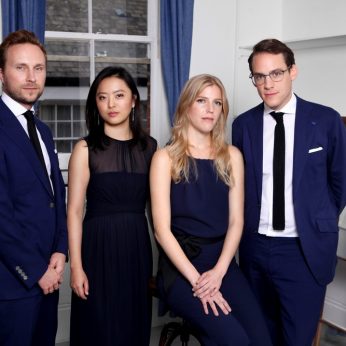Composer: Béla Bartók (b. 1881 - d. 1945)
Performance date: 28/06/2022
Venue: Bantry House
Composition Year: 1927
Duration: 00:16:11
Recording Engineer: Eduardo Prado, Ergodos
Instrumentation: 2vn, va, vc
Instrumentation Category:String Quartet
Artists:
Doric String Quartet (Alex Redington, Ying Xue [violins], Hélène Clément [viola], John Myerscough [cello] -
[quartet]

Béla Bartók [1881–1945]
String Quartet No. 3 Sz. 85 [1927]
1. Prima parte: Moderato – attaca
2. Seconda parte: Allegro – attaca
3. Ricapitulazione della prima parte: Moderato
Coda: Allegro molto
The size and musical significance of the string quartet has changed radically ever since the 18th century when Haydn’s quartets were pre-eminent and quartets were generally published in sets of six. Then in Beethoven’s lifetime cycles of even two or three quartets became rarer, and this trend culminated in his late string quartets, just one of which could stand alone and carry the same weight as a symphony. Bartók’s six string quartets, which he wrote between 1908 and 1939, continued the transformation of the character and function of composition in general, and the string quartet in particular, and his quartets occupy a central position, both in his output and in 20th century music.
Bartók wrote his Third String Quartet in September 1927, by which time his style had become much more personal. So the work is a distillation of his most distinctive stylistic traits, including his fascination with the characteristics of the music of the many ethnic minorities in the Hungarian section of the Austro-Hungarian Empire, which included Slovak, Romanian, Ruthenian, Serbian, Bulgarian and Transylvanian communities. He had collected their traditional music with Kodály in the early years of the century and believed that the music and the musical energy of the rural communities was a natural phenomenon, which had the potential to reform both the nation’s musical life and his own musical approach. In his quartets he relied on short motifs and so the traditional style particularly appealed to him because of its small-scale completeness.
His Third Quartet is renowned for the extreme concentration and violence of its language. The prima parte, after a mysterious 5-bar introduction, takes the form of a triptych whose central episode metamorphoses into strange and rarified nocturnal music punctuated by growls and cries. Moments of aggression are tempered by unexpected glimpses of lyricism, swiftly forgotten. The strongly contrasted seconda parte features Hungarian folk dance elements especially a driving rhythmic energy. His language is harsh, using pitilessly dissonant intervals and a veritable dictionary of sound effects, which drive the expressive tension to a peak. Mastering this music is a huge test of a Quartet’s resolve and technical ability. The Ricapitulazione sets out to concentrate even further the already highly compressed prima parte, giving the listener brief reminiscences of a half-forgotten dream before a virtuoso summary of the seconda parte drives to an explosive finish.
Sarah Burn
Copyright © 2025 West Cork Music. All rights reserved.
Designed and developed by Matrix Internet